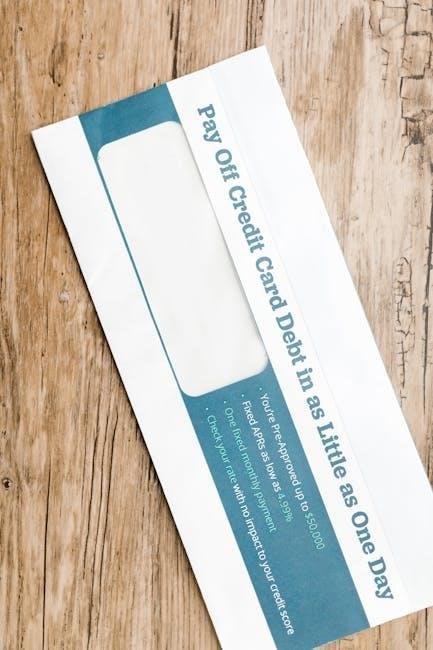A pay for deletion letter is a strategic tool used to negotiate the removal of negative credit entries in exchange for payment. It helps improve credit scores by eliminating derogatory marks, offering consumers a fresh financial start. This letter is sent to creditors or collection agencies, proposing a settlement in exchange for clearing debt records from credit reports. It’s an effective tactic for credit repair and rebuilding financial health.
Understanding the Purpose of a Pay for Deletion Letter
A pay for deletion letter is a written request to creditors or debt collectors to remove negative entries from a credit report in exchange for settling the debt. Its primary goal is to improve credit scores by eliminating derogatory marks, such as late payments or collections. By offering to pay a portion of the debt (often 40-80% of the total), consumers aim to negotiate the removal of negative information, which can significantly enhance their financial standing and access to better credit opportunities.
Importance of Credit Reports and Negative Entries
Credit reports play a crucial role in determining financial health, influencing loan approvals, interest rates, and employment opportunities. Negative entries, such as late payments or collections, can significantly lower credit scores, making it harder to secure favorable credit terms. These entries remain on reports for up to seven years, impacting creditworthiness and financial stability. Addressing these issues through strategies like pay for deletion letters can help improve credit scores and open doors to better financial opportunities, ensuring long-term economic well-being.
What is a Pay for Deletion Letter?
A pay for deletion letter is a written proposal to creditors, offering to settle a debt in exchange for removing negative entries from credit reports. It’s a negotiation tool aimed at improving credit scores by eliminating derogatory marks, fostering credit repair and financial recovery. This strategic approach allows individuals to regain control over their credit history, fostering better financial health and future opportunities.
Definition and Function
A pay for deletion letter is a written agreement between a consumer and a creditor or collection agency. It proposes settling a debt in exchange for removing negative entries from credit reports. This letter functions as a negotiation tool, allowing consumers to offer a percentage of the owed amount (typically 40-80%) to clear the debt and eliminate derogatory marks. Its primary purpose is to improve credit scores and financial standing, offering individuals a pathway to repair their credit history and achieve better financial health. It is a customizable strategy for addressing past debts and rebuilding creditworthiness.
Difference Between Pay for Delete and Goodwill Letters
A Pay for Delete letter is a negotiation tool where consumers offer to pay a portion of a debt in exchange for the creditor removing the negative entry from their credit report. In contrast, a Goodwill letter requests the removal of negative information without offering payment, often after the debt has been settled. Pay for Delete is transactional, linking payment to removal, while Goodwill letters appeal to the creditor’s compassion. Both aim to improve credit scores but differ in approach and conditions.

The Process of Using a Pay for Deletion Letter
The process involves drafting a pay for deletion letter, sending it to creditors, and awaiting their response. It’s a strategic approach to negotiate debt removal.
Identifying Eligible Negative Entries
Eligible negative entries for a pay for deletion letter include late payments, collections, and charge-offs. Review your credit report to identify inaccuracies or outdated information. Focus on debts that are valid but negatively impacting your score. Prioritize accounts with higher balances or more recent delinquencies, as these have a greater impact. Ensure the debt is within the statute of limitations and verifiable. Accurate documentation is key to a successful negotiation.
Preparing for Negotiation
Before drafting a pay for deletion letter, gather detailed information about the debt, including the balance and account history. Determine a realistic settlement percentage, typically between 40-80% of the owed amount. Research the creditor’s policies on debt settlement and deletion. Organize supporting documents, such as payment receipts or correspondence. Plan your negotiation strategy, ensuring clarity and professionalism in your approach. Understand your rights and the creditor’s obligations under credit reporting laws to strengthen your case.

Key Components of a Pay for Deletion Letter
A pay for deletion letter must include your personal information, account details, a clear settlement offer, and a request for negative entry removal. Maintain a polite tone.
Essential Information to Include
Your pay for deletion letter must include your full name, address, and contact details, along with the creditor’s name and address. Clearly state the account number and the amount you’re willing to pay. Specify the negative entry you’re addressing and request its removal from your credit report. Include a statement that the creditor must confirm the agreement in writing. Mention the payment method and deadline. Keep the tone professional and polite to ensure a positive response.
Structure and Tone Guidelines
Your pay for deletion letter should be clear, professional, and concise. Start with your contact information, followed by the creditor’s details. State the account number and the amount you’re willing to pay. Politely request the removal of the negative entry from your credit report in exchange for payment. Avoid aggressive language and maintain a respectful tone. Clearly outline the terms and expectations, ensuring the letter is well-organized and easy to understand. This approach increases the likelihood of a favorable response.

Templates and Examples
Pay for deletion letter templates provide structured examples, guiding users to draft effective letters for negotiating the removal of negative credit entries, ensuring clarity and professionalism.
Locating Reliable Pay for Deletion Templates
Reliable pay for deletion letter templates can be found on legal and financial websites, offering free or paid options. Many platforms provide downloadable PDFs, ensuring professional formatting and content. Credit repair agencies and legal resources often share customizable templates tailored to specific needs. When selecting a template, ensure it includes essential sections like debtor and creditor details, settlement offers, and removal requests. Look for examples labeled as “Sample Pay For Delete Letter” or “Debt Validation Templates” to guarantee accuracy and relevance.
Customizing Templates for Personal Use
Customizing pay for deletion templates ensures they meet specific needs. Start by editing the template to include personal and account details, such as name, address, and account number. Clearly state the proposed settlement amount and request removal of negative entries. Save the finalized version as a PDF for professional presentation. Tailor the tone to reflect your situation, ensuring clarity and professionalism. Customize sections to address specific debts or creditors, making the letter precise and relevant to your case.
Submitting the Letter
Submit your pay for deletion letter via certified mail or email for tracking; Ensure it’s addressed to the creditor or collection agency, with clear instructions for delivery. Include a return receipt to confirm receipt and maintain professionalism throughout. Follow up within 30 days to verify processing and outcomes. Keep copies for your records to track progress and ensure accountability. Proper submission enhances the likelihood of successful negotiation and removal of negative entries from your credit report.
Methods of Submission and Follow-Up
Submit the pay for deletion letter via certified mail or email for tracking. Include a return receipt to confirm delivery. Follow up within 30 days to verify receipt and progress. Use online portals if available for faster submission. Maintain a professional tone and keep records of all communications. Track responses carefully to ensure the creditor acknowledges your request. Consider sending a follow-up letter if no response is received within the expected timeframe. Proper documentation and consistent follow-up are key to achieving a successful outcome and ensuring accountability throughout the process.
Tracking Responses and Outcomes
After submitting the pay for deletion letter, track responses by monitoring delivery confirmations and creditor acknowledgments. Follow up with a phone call or email if no response is received within 30 days. Verify outcomes by checking your credit report for the removal of negative entries. Keep detailed records of all communications and outcomes. If the creditor agrees, ensure the deletion is reflected on all major credit bureaus. Persistent follow-up is crucial to confirm the desired changes and maintain accurate documentation for future reference and accountability.

Negotiation Strategies
Negotiation strategies involve offering a percentage of the debt, typically between 40-80%, to creditors in exchange for removal of negative entries. Start with a lower offer and escalate if necessary. Professional communication and persistence are key to achieving favorable outcomes. The goal is to secure a written agreement for deletion upon payment. Always maintain a polite and firm tone to build credibility and trust with creditors during negotiations.
Understanding Settlement Percentages
Settlement percentages in pay for deletion agreements typically range from 40% to 80% of the outstanding debt. This means consumers offer a portion of the owed amount in exchange for the creditor’s agreement to remove the negative entry from their credit report. Starting with a lower offer, such as 40%, allows room for negotiation. Creditors are more likely to accept settlements that demonstrate goodwill and a commitment to resolving the debt. Ensuring the agreement is in writing protects both parties and guarantees the deletion upon payment. This strategy is crucial for effective credit repair and rebuilding financial health.
Effective Communication with Creditors
Effective communication with creditors is key to successful pay for deletion negotiations. Be clear, concise, and polite in your interactions. Start by stating your intent to settle the debt and propose a specific percentage or amount you are willing to pay. Always request written confirmation of the agreement, ensuring the creditor agrees to remove the negative entry from your credit report. Maintain a professional tone and avoid confrontational language. This approach fosters cooperation and increases the likelihood of a favorable outcome, helping you achieve your credit repair goals.
Legal and Ethical Considerations
When drafting a pay for deletion letter, ensure compliance with credit reporting laws and ethical practices. Understand your rights under the Fair Credit Reporting Act and maintain transparency in negotiations to avoid legal disputes.
Knowing Your Rights as a Consumer
Under the Fair Credit Reporting Act, consumers have the right to dispute inaccuracies and request investigations into credit report errors. When using a pay for deletion letter, it’s important to understand that while creditors are not legally obligated to remove negative entries, they may agree as a goodwill gesture. Knowing your rights ensures you approach negotiations ethically and within legal boundaries, protecting your financial interests while seeking to improve your credit standing.
Abiding by Credit Reporting Laws
When drafting a pay for deletion letter, it’s crucial to comply with credit reporting laws. The Fair Credit Reporting Act ensures accuracy and fairness in credit reports, requiring creditors to investigate disputes. While pay for delete agreements are not mandated by law, they must align with legal standards. Ensuring transparency and avoiding misleading statements in your letter helps maintain compliance, protecting both parties and fostering a lawful negotiation process.

Success Stories and Case Studies
Real-life examples highlight successful negotiations where pay for deletion letters led to the removal of negative entries, significantly improving credit scores and financial standing for individuals.
Real-Life Examples of Successful Negotiations
One individual used a pay for deletion letter to settle a $2,000 credit card debt for 60%, with the creditor agreeing to remove the negative entry. Another case involved a medical debt of $1,500, where the collector accepted 50% and deleted the item. These examples demonstrate how effective negotiation can lead to improved credit scores and financial recovery. Such success stories highlight the practical benefits of using pay for deletion letters to address debt and enhance credit profiles effectively.
Lessons Learned from Failed Attempts
Failed pay for deletion attempts often stem from improper letter drafting or negotiation strategies. For instance, using generic templates without customization can reduce credibility. Some individuals neglect to follow up after submission, leading to ignored requests. Additionally, failing to understand legal frameworks or not addressing specific debt details can hinder success. These mistakes highlight the importance of thorough preparation, personalized communication, and persistent follow-up to achieve favorable outcomes in debt negotiations and credit repair efforts.

Common Mistakes to Avoid
Using generic templates without customization, neglecting to follow up, and ignoring legal frameworks are common pitfalls. Ensure personalized communication and avoid vague language to improve success rates.
Pitfalls in Letter Writing and Negotiation
When drafting a pay for deletion letter, avoid using overly aggressive language, as it may harm negotiations. Ensure clarity and professionalism, clearly stating the proposed settlement terms. Failing to include specific details, such as the account number and the exact amount offered, can lead to confusion. Additionally, avoid making unrealistic demands or threats, as this may discourage creditors from responding. Always include a clear call to action, requesting written confirmation of the agreement. Proper formatting and tone are essential to maintain credibility and increase the likelihood of a successful outcome.
Consequences of Incorrect Procedures
Incorrectly drafting a pay for deletion letter can lead to ineffective negotiations and unchanged credit reports. Using an unprofessional tone or omitting crucial details may result in the letter being ignored. Submitting inaccurate information or failing to adhere to legal standards can harm your credibility. Additionally, neglecting to request written confirmation of the agreement may leave negative entries unchanged. Improper procedures can also delay resolution, potentially worsening financial standing. Ensuring accuracy and compliance with credit laws is essential to avoid these negative outcomes and achieve desired results.

Alternatives to Pay for Deletion
Besides pay for deletion, options like goodwill letters, disputing errors, or debt validation can address negative credit entries. These strategies offer different approaches to credit repair.
Other Strategies for Credit Repair
Beyond pay for deletion, other effective credit repair strategies include goodwill letters, which request creditors to remove negative entries as a gesture of goodwill. Disputing errors on credit reports through official channels can also correct inaccuracies. Additionally, debt validation involves requesting proof of debt from collectors, potentially leading to its removal if unverified. Paying down debt, building positive credit history, and monitoring credit reports are also essential for overall financial health and score improvement.
When to Seek Professional Assistance
Seeking professional help is advisable when dealing with complex credit issues or multiple negative entries. Credit counseling agencies can provide personalized strategies and negotiate on your behalf. If DIY methods like pay for deletion letters aren’t yielding results, professionals can offer tailored solutions. Legal advice is recommended for disputes or identity theft cases. Additionally, financial advisors can help create long-term plans for debt management and credit score improvement, ensuring sustainable financial health.

and Final Thoughts
Summarizing the Pay for Deletion Process
A pay for deletion letter is a powerful tool to remove negative credit entries, offering a path to better credit scores. By negotiating settlements, consumers can rebuild their financial standing effectively.
A pay for deletion letter is a strategic tool for credit repair, enabling individuals to negotiate the removal of negative entries from their credit reports. The process involves drafting a letter to creditors or collection agencies, proposing a settlement in exchange for deleting derogatory marks. This approach can significantly improve credit scores by eliminating late payments, collections, or other negative items. Success depends on clear communication, a reasonable settlement offer, and the creditor’s willingness to remove the entries post-payment. Proper execution can lead to a cleaner credit profile and enhanced financial health.
Encouragement and Next Steps
Embarking on the pay for deletion process can be a transformative step toward improving your credit health. By taking proactive measures to remove negative entries, you’re investing in a stronger financial future. Start by downloading a reliable template, customizing it with your details, and confidently submitting it to your creditors. Stay persistent, maintain professional communication, and follow up diligently. Remember, every successful negotiation brings you closer to a cleaner credit profile and better financial opportunities. Take control today and pave the way for long-term financial stability.

Additional Resources
Explore recommended websites and templates for crafting pay for deletion letters. Consider professional services for personalized assistance and expert guidance in credit repair.
Recommended Reading and Websites
Access reliable websites offering free pay for deletion letter templates and comprehensive guides. Visit credit repair forums and financial advice platforms for expert tips. Downloadable PDF templates are available on legal and financial websites, ensuring proper formatting and structure. Explore resources like Credit Karma and NerdWallet for detailed instructions. Utilize these tools to craft effective letters and negotiate successfully with creditors, enhancing your credit repair journey with proven strategies and examples.
Professional Services for Further Help
For expert assistance, consider consulting credit counseling agencies or financial advisors specializing in credit repair. Professional services can review your pay for deletion letter, ensuring it meets legal standards and is effectively negotiated. Reputable companies like Lexington Law and CreditRepair.com offer tailored solutions to remove negative entries. These services provide personalized strategies, accelerating the process and improving outcomes. Utilize their expertise to streamline negotiations and achieve optimal results, ensuring your financial recovery is both efficient and successful.
Frequently Asked Questions
- What is a pay for deletion letter? It’s a written request to creditors to remove negative credit entries after a settlement is paid.
Addressing Common Queries
Common questions about pay for deletion letters include understanding their purpose, how they work, and their success rates. Many wonder if creditors always honor such requests and how to draft an effective letter. Others inquire about the necessary information to include, such as account details and settlement offers. Additionally, people often ask where to find reliable templates and whether legal assistance is required. These FAQs highlight the importance of clarity and precision when using this credit repair strategy.
Clarifying Doubts and Concerns
Clarifying doubts about pay for deletion letters involves understanding their legality and ethical implications. Many worry about whether offering partial payment will harm their credit score further. Others are concerned about the enforceability of such agreements and whether creditors will follow through on their promises. Additionally, there are questions about the proper formatting and tone of the letter, as well as the best methods for submission and follow-up. Addressing these concerns ensures a clear and effective negotiation process with creditors.




Leave a Reply
You must be logged in to post a comment.